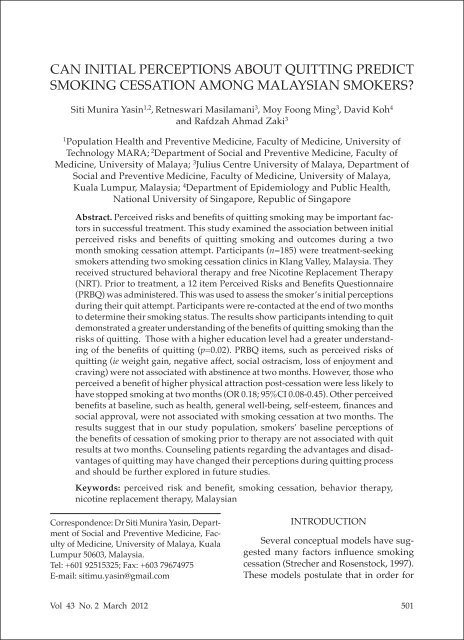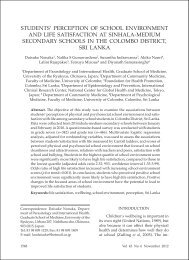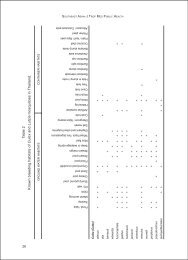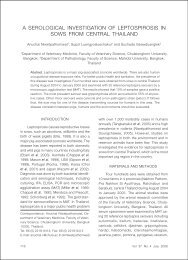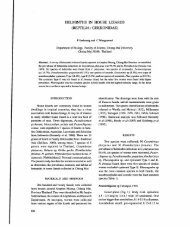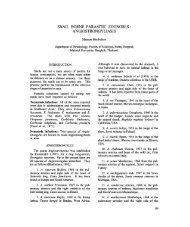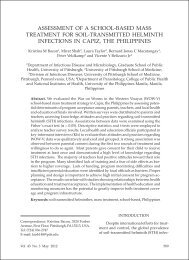can initial perceptions about quitting predict smoking cessation ...
can initial perceptions about quitting predict smoking cessation ...
can initial perceptions about quitting predict smoking cessation ...
You also want an ePaper? Increase the reach of your titles
YUMPU automatically turns print PDFs into web optimized ePapers that Google loves.
InItIal PerceIved rIsks and BenefIts of smoke cessatIon<br />
CAN INITIAL PERCEPTIONS ABOUT QUITTING PREDICT<br />
SMOKING CESSATION AMONG MALAYSIAN SMOKERS?<br />
Siti Munira Yasin 1,2 , Retneswari Masilamani 3 , Moy Foong Ming 3 , David Koh 4<br />
and Rafdzah Ahmad Zaki 3<br />
1 Population Health and Preventive Medicine, Faculty of Medicine, University of<br />
Technology MARA; 2 Department of Social and Preventive Medicine, Faculty of<br />
Medicine, University of Malaya; 3 Julius Centre University of Malaya, Department of<br />
Social and Preventive Medicine, Faculty of Medicine, University of Malaya,<br />
Kuala Lumpur, Malaysia; 4 Department of Epidemiology and Public Health,<br />
National University of Singapore, Republic of Singapore<br />
Abstract. Perceived risks and benefits of <strong>quitting</strong> <strong>smoking</strong> may be important factors<br />
in successful treatment. This study examined the association between <strong>initial</strong><br />
perceived risks and benefits of <strong>quitting</strong> <strong>smoking</strong> and outcomes during a two<br />
month <strong>smoking</strong> <strong>cessation</strong> attempt. Participants (n=185) were treatment-seeking<br />
smokers attending two <strong>smoking</strong> <strong>cessation</strong> clinics in Klang Valley, Malaysia. They<br />
received structured behavioral therapy and free Nicotine Replacement Therapy<br />
(NRT). Prior to treatment, a 12 item Perceived Risks and Benefits Questionnaire<br />
(PRBQ) was administered. This was used to assess the smoker’s <strong>initial</strong> <strong>perceptions</strong><br />
during their quit attempt. Participants were re-contacted at the end of two months<br />
to determine their <strong>smoking</strong> status. The results show participants intending to quit<br />
demonstrated a greater understanding of the benefits of <strong>quitting</strong> <strong>smoking</strong> than the<br />
risks of <strong>quitting</strong>. Those with a higher education level had a greater understanding<br />
of the benefits of <strong>quitting</strong> (p=0.02). PRBQ items, such as perceived risks of<br />
<strong>quitting</strong> (ie weight gain, negative affect, social ostracism, loss of enjoyment and<br />
craving) were not associated with abstinence at two months. However, those who<br />
perceived a benefit of higher physical attraction post-<strong>cessation</strong> were less likely to<br />
have stopped <strong>smoking</strong> at two months (OR 0.18; 95%CI 0.08-0.45). Other perceived<br />
benefits at baseline, such as health, general well-being, self-esteem, finances and<br />
social approval, were not associated with <strong>smoking</strong> <strong>cessation</strong> at two months. The<br />
results suggest that in our study population, smokers’ baseline <strong>perceptions</strong> of<br />
the benefits of <strong>cessation</strong> of <strong>smoking</strong> prior to therapy are not associated with quit<br />
results at two months. Counseling patients regarding the advantages and disadvantages<br />
of <strong>quitting</strong> may have changed their <strong>perceptions</strong> during <strong>quitting</strong> process<br />
and should be further explored in future studies.<br />
Keywords: perceived risk and benefit, <strong>smoking</strong> <strong>cessation</strong>, behavior therapy,<br />
nicotine replacement therapy, Malaysian<br />
Correspondence: Dr Siti Munira Yasin, Department<br />
of Social and Preventive Medicine, Faculty<br />
of Medicine, University of Malaya, Kuala<br />
Lumpur 50603, Malaysia.<br />
Tel: +601 92515325; Fax: +603 79674975<br />
E-mail: sitimu.yasin@gmail.com<br />
Vol 43 No. 2 March 2012<br />
INTRODUCTION<br />
Several conceptual models have suggested<br />
many factors influence <strong>smoking</strong><br />
<strong>cessation</strong> (Strecher and Rosenstock, 1997).<br />
These models postulate that in order for<br />
501
<strong>smoking</strong> <strong>cessation</strong> to occur, an individual<br />
must first perceive personal vulnerability<br />
to its negative outcomes (Rosenstock,<br />
1974). They must understand the outcome<br />
is severe, and <strong>quitting</strong> will reduce the<br />
likelihood of their personal susceptibility<br />
(Weinstein, 1988).<br />
While some studies have explored the<br />
characteristics of smokers regarding the<br />
perceived risks and benefits of <strong>quitting</strong> on<br />
<strong>smoking</strong> initiation and intensity (Lyna et<br />
al, 2002), few studies have examined the<br />
perceived risks versus benefits of <strong>smoking</strong><br />
<strong>cessation</strong>. It is also unclear how these<br />
beliefs affect their <strong>cessation</strong> outcomes. For<br />
example, a study in the US found the perceived<br />
benefits were positively related to<br />
motivation, while the perceived risks were<br />
negatively related to it. Perceived risks<br />
have also been shown to be negatively related<br />
to the outcome of treatment (McKee<br />
et al, 2005). Another study (Weinberger<br />
et al, 2008), examined the effect of perceived<br />
risks on treatment outcome concluded<br />
participants with greater know-<br />
ledge of perceived risks found it more<br />
difficult to quit and not restart.<br />
In this study we aimed to answer two<br />
questions: what are the characteristics of<br />
Malaysian smokers in relation to their<br />
perceived risks and benefits of <strong>quitting</strong><br />
<strong>smoking</strong> and is there an association between<br />
<strong>initial</strong> perceived risks and benefits<br />
of <strong>smoking</strong> <strong>cessation</strong> and <strong>smoking</strong> <strong>cessation</strong><br />
at two months?<br />
MATERIALS AND METHODS<br />
Participant recruitment<br />
We carried out a prospective study,<br />
recruiting participants and administering<br />
a written questionnaire at baseline<br />
and following them up for eight weeks.<br />
The study was conducted from November<br />
2009 to April 2010. Participants were<br />
southeast asIan J troP med PuBlIc health<br />
<strong>smoking</strong> staff of two public universities<br />
in Klang Valley, who were interested in<br />
<strong>quitting</strong> <strong>smoking</strong>.<br />
Letters of invitations were sent to the<br />
heads of all departments at each university<br />
one month prior to the program. All<br />
staff received e-mails inviting them to<br />
participate. The sessions were conducted<br />
during office hours.<br />
In order to be eligible for the study,<br />
participants had to be daily cigarette<br />
smokers (during the previous 12 months)<br />
and want to quit <strong>smoking</strong>. They had to be<br />
able to communicate in either Bahasa Malaysia<br />
(the national language) or English<br />
and agree to use Nicotine Replacement<br />
Therapy (NRT). Subjects were excluded<br />
if they had a recent myocardial infarction,<br />
life-threatening arrhythmia, severe<br />
or worsening angina or had an allergy to<br />
any component of the medication. The<br />
study was approved by the Medical Ethics<br />
Committees of both Universities.<br />
Clinic site preparation and program<br />
We set up a temporary <strong>smoking</strong> <strong>cessation</strong><br />
clinic at each university. The session<br />
was given by a medical doctor and an assistant.<br />
It covered both behavioral therapy<br />
and pharmacotherapy. Participants attended<br />
clinics by appointment.<br />
During the clinic appointment, participants<br />
received general information regarding<br />
the study. After giving informed<br />
consent in writing, they were each given<br />
a Perceived Risk and Benefit Questionnaire<br />
(PRBQ), and sociodemographic<br />
and <strong>smoking</strong> history questionnaires. All<br />
participants were shown a Power Point<br />
presentation in a small group of 4-5 individuals.<br />
The educational session covered:<br />
1) epidemiology and pathophysiology<br />
of <strong>smoking</strong>; 2) risks and impact of first<br />
and second hand <strong>smoking</strong> on self, family<br />
and the environment and; 3) the benefits<br />
502 Vol 43 No. 2 March 2012
InItIal PerceIved rIsks and BenefIts of smoke cessatIon<br />
of <strong>smoking</strong> <strong>cessation</strong>. Participants were<br />
taught how to set a quit date and how to<br />
use NRT. Participants were given NRT<br />
gum for 1 month. At two months, participants<br />
were contacted by telephone to<br />
determine their <strong>smoking</strong> status.<br />
Measures<br />
Baseline characteristics and <strong>smoking</strong> status<br />
assessment. Basic demographic characteristics<br />
included age, education level marital<br />
status, and occupation. A <strong>smoking</strong> history<br />
questionnaire was developed for this study<br />
and included age started <strong>smoking</strong>, the<br />
amount smoked before <strong>quitting</strong> and number<br />
of previous attempts to quit. Smoking<br />
<strong>cessation</strong> was assessed via a telephone<br />
call at two months. Systematic reviews of<br />
<strong>smoking</strong> <strong>cessation</strong> studies confirmed for<br />
low intensity interventions, biochemical<br />
validation is not necessary (Patrick et al,<br />
1994).<br />
Perceived risks and benefits of <strong>quitting</strong><br />
(PRBQ). The PRBQ Questionnaire assessed<br />
patients’ <strong>perceptions</strong> regarding perceived<br />
risks and benefits of <strong>quitting</strong> <strong>smoking</strong>.<br />
It is a modified, shorter version of the<br />
original PRBQ Questionnaire consisting of<br />
22 items (McKee et al, 2005). These items<br />
were grouped into six categories of benefit<br />
(health, well being, finances, self-esteem,<br />
social approval and physical appeal/attraction)<br />
and six categories of risk (increase<br />
in negative affect, weight gain, reduced<br />
ability to concentrate, social ostracism,<br />
loss of enjoyment and craving). A Likert<br />
scale of 1 to 5 was used, with 1 being “no<br />
chance”, 2 being “unlikely, 3 being “moderate<br />
chance”, 4 “likely” and 5 “certain to<br />
happen”.<br />
Prior to administration of the questionnaire,<br />
all materials were translated<br />
into Bahasa Malaysia and field tested for<br />
appropriate translation and vocabulary.<br />
The average item scores were used as a<br />
Vol 43 No. 2 March 2012<br />
scale score for PRBQ.<br />
Statistical methods<br />
The results were analyzed using SPSS<br />
version 15.0. (SPSS, College Station, TX).<br />
Patients’ demographic characteristics<br />
were presented using frequency counts,<br />
means and ranges. We evaluated differences<br />
in perceived risks and benefits using<br />
a chi-square test for categorical variables<br />
and a t-test or ANNOVA for continuous<br />
variables with sociodemographic characteristics<br />
and <strong>smoking</strong> history. We conducted<br />
univariate analysis and stepwise<br />
logistic regression of all these variables to<br />
find signifi<strong>can</strong>t PRBQ <strong>predict</strong>ors of <strong>quitting</strong><br />
success.<br />
We defined point prevalence quit rate<br />
as not <strong>smoking</strong> during the past seven days<br />
at the two month telephone interview.<br />
Smoking status at the <strong>initial</strong> visit was confirmed<br />
by CO ppm measurement (using a<br />
Bradford CO analyzer) of ≥ 6 ppm. Results<br />
at two months were reported without any<br />
biochemical validation. We used intention<br />
to treat analysis in assessing quit rates. In<br />
this analysis, subjects who could not be<br />
contacted (refused, changed their phone<br />
number, or intentionally gave the wrong<br />
telephone number) were considered to<br />
have continued <strong>smoking</strong>. Subjects who<br />
used NRT daily for at least two weeks, as<br />
evidenced by a <strong>smoking</strong> <strong>cessation</strong> diary<br />
were defined as adherent to NRT. Subjects<br />
who refused or took NRT for less than<br />
two weeks were considered not adherent<br />
to NRT.<br />
RESULTS<br />
Subjects characteristics<br />
There were 138 and 47 respondents<br />
from University A and University B,<br />
respectively. Participants reported they<br />
started <strong>smoking</strong> at an average age of<br />
503
17 years old (Range 9-42). The average<br />
number of cigarettes smoked per day<br />
was 14 cigarettes (Range 2-40). Mean CO<br />
measurement at the first visit was 15.5<br />
ppm. The backgrounds and <strong>smoking</strong><br />
characteristics of participants [ie, education<br />
status, ethnic group (Malay and<br />
Non-Malay), occupational status, marital<br />
status, previous quit attempts and adherence<br />
to NRT], at the two universities were<br />
not signifi<strong>can</strong>tly different from each other<br />
(p>0.05) (Table 1).<br />
Success rates<br />
At the end of 8 weeks 27% (n=50)<br />
of participants stated they had given<br />
up <strong>smoking</strong>. Using an intention to treat<br />
approach, 10 participants, whose <strong>smoking</strong><br />
status were unknown by 2 months<br />
(defaulted or could not be contacted via<br />
telephone), were considered as continuing<br />
to smoke.<br />
Forty-one point one percent were<br />
noncompliant with NRT either due to side<br />
effects or they failed to follow-up. The<br />
success rates of those adherent to NRT<br />
was 2.34 times that of those non-adherent<br />
to NRT at two months; this was statistically<br />
signifi<strong>can</strong>t (Odds ratio 2.34; 95% CI<br />
1.35-3.32).<br />
Total perceived risks and benefits of <strong>quitting</strong><br />
<strong>smoking</strong> by sociodemographic and<br />
<strong>smoking</strong> history variables<br />
We compared the PRBQ scores against<br />
the sociodemographic and <strong>smoking</strong> history<br />
characteristics. Smokers aged >51 years,<br />
were less likely to perceive the benefit of<br />
<strong>smoking</strong> <strong>cessation</strong>, compared to younger<br />
smokers, although this difference was not<br />
signifi<strong>can</strong>t (p=0.07). Higher education was<br />
associated with higher perceived risks and<br />
benefits of <strong>quitting</strong> (p=0.02). There was no<br />
signifi<strong>can</strong>t difference in any of the other<br />
sociodemographic characteristics or <strong>smoking</strong><br />
histories (Table 2).<br />
southeast asIan J troP med PuBlIc health<br />
Table 1<br />
Subject demographic and <strong>smoking</strong><br />
characteristics.<br />
Demographic and <strong>smoking</strong> n (%)<br />
characteristics<br />
Age group (years)<br />
18-29 77 (41.6)<br />
30-40 43 (23.2)<br />
41-50 43 (23.2)<br />
≥ 51 22 (11.9)<br />
Ethnic group<br />
Malay 176 (95.1)<br />
Non-Malay 9 (4.9)<br />
Education level<br />
Primary school 5 (2.7)<br />
Secondary school 106 (57.9)<br />
Diploma and above 72 (39.3)<br />
Occupational<br />
Support group 171 (93.4)<br />
Professional 14 (6.6)<br />
Marital status<br />
Single 69 (37.3)<br />
Married 113 (61.1)<br />
Divorced 3 (1.6)<br />
Smoking history<br />
Number of cigarettes/day<br />
< 10 27 (14.6)<br />
≥ 10 158 (85.4)<br />
Age started <strong>smoking</strong> (years)<br />
8-12 18 (9.7)<br />
13-18 121 (65.4)<br />
≥ 19 46 (24.9)<br />
Previous quit attempts<br />
0 27 (14.6)<br />
≥ 1 158 (85.4)<br />
NRT used<br />
Non-adherent 109 (41.1)<br />
Adherent 76 (58.9)<br />
Perceived risks and benefits associated<br />
with abstinence<br />
Those who successfully quit at two<br />
months were compared with those who<br />
still smoked using an independent sample<br />
504 Vol 43 No. 2 March 2012
InItIal PerceIved rIsks and BenefIts of smoke cessatIon<br />
Table 2<br />
Sociodemographic and <strong>smoking</strong> history variables by Perceived Risk and<br />
Benefit Qusetionnaire.<br />
Demographic and <strong>smoking</strong> Total F p-value Total F p-value<br />
characteristics perceived perceived<br />
risk (mean) benefit risk<br />
(mean)<br />
Age group (years)<br />
18-29 3.42 0.61 0.61 4.26 4.16 0.07 a<br />
30-40 3.28 4.35<br />
41-50 3.38 4.17<br />
≥ 51 3.46 3.79<br />
Ethnic group<br />
Malay 3.39 0.25 0.87 4.21 1.00 0.77<br />
Non-Malay 3.35 4.13<br />
Education level<br />
Primary school 3.17 0.60 0.55 3.40 3.88 0.02 b<br />
Secondary school 3.38 4.18<br />
Diploma and above 3.43 4.27<br />
Occupational<br />
Support group 3.38 0.04 0.84 4.21 0.06 0.81<br />
Professionals 3.35 4.16<br />
Marital status<br />
Single 3.39 0.28 0.76 4.20 0.27 0.76<br />
Married 3.39 4.20<br />
Divorced 3.08 4.53<br />
Age group (years)<br />
18-29 3.42 0.61 0.61 4.26 4.16 0.07 a<br />
30-40 3.28 4.35<br />
41-50 3.38 4.17<br />
≥ 51 3.46 3.79<br />
Ethnic group<br />
Malay 3.39 0.25 0.87 4.21 1.00 0.77<br />
Non-Malay 3.35 4.13<br />
Education level<br />
Primary school 3.17 0.60 0.55 3.40 3.88 0.02 b<br />
Secondary school 3.38 4.18<br />
Diploma and above 3.43 4.27<br />
Occupational<br />
Support group 3.38 0.04 0.84 4.21 0.06 0.81<br />
Professionals 3.35 4.16<br />
Marital status<br />
Single 3.39 0.28 0.76 4.20 0.27 0.76<br />
Married 3.39 4.20<br />
Divorced 3.08 4.53<br />
a p
t-tests. Quitters had lower scores on physical<br />
appeal (t=-0.236, p0.05) (Table 3).<br />
Multivariate analysis of 21 variables<br />
of <strong>predict</strong>ors for <strong>cessation</strong> at two months<br />
included 13 perceived risks and benefits<br />
variables and 8 sociodemographic and social<br />
history variables. Of those variables, 4<br />
signifi<strong>can</strong>t PRBQ variables were included<br />
in the final model. They were health benefits,<br />
general well being, physical appeal<br />
and self esteem. After controlling for age,<br />
number of cigarettes smoked per day,<br />
work category and NRT adherence, there<br />
was only one PRBQ variable found to <strong>predict</strong><br />
abstinence at two months. A higher<br />
physical appeal score strongly <strong>predict</strong>ed<br />
lack of <strong>smoking</strong> <strong>cessation</strong> at two months<br />
(Wald=13.59; p3.00 on the risks<br />
and benefits of <strong>quitting</strong>. The majority of<br />
smokers were also aware that the bene-<br />
fits of <strong>quitting</strong> outweighed the risks of<br />
<strong>quitting</strong>. This is similar to a study among<br />
cardiovascular patients (Wiggers et al,<br />
2005). Their study suggested patients who<br />
wanted to quit <strong>smoking</strong> felt their life was<br />
better after <strong>quitting</strong> than it would have<br />
been if they continued to smoke.<br />
Our findings suggest a higher education<br />
status was related to greater awareness<br />
of the negative effects of <strong>smoking</strong>.<br />
A local household survey involving<br />
11,000 people regarding knowledge and<br />
southeast asIan J troP med PuBlIc health<br />
attitudes of smokers older than 18 years<br />
found a greater knowledge among more<br />
educated smokers (Lim et al, 2009). Although<br />
Malaysia has spent a considerable<br />
amount of money to carry out several<br />
nationwide anti-<strong>smoking</strong> campaigns, including<br />
mass media education, <strong>smoking</strong><br />
<strong>cessation</strong> clinics and telephone quitlines<br />
(Aljunid, 2006), the prevalence of smokers<br />
in Malaysia only decreased from 23.5% to<br />
21.5% over 10 years. A possible explanation<br />
is our efforts may not have reached<br />
the lower socioeconomic class and less<br />
educated smokers. Hence, the “one size<br />
fits all” approach may have been ineffective<br />
and inappropriate. To reach these<br />
groups, intervention materials need to<br />
meet appropriate literacy levels and complex<br />
information should be conveyed in a<br />
manner easily understood.<br />
In contrast to studies conducted by<br />
McKee et al (2005) and Weinberger et al<br />
(2008) we found only one signifi<strong>can</strong>t <strong>predict</strong>or<br />
of unsuccessful <strong>quitting</strong> after controlling<br />
for confounders. A higher <strong>initial</strong><br />
perceived benefit of physical attraction<br />
among our population was found to be<br />
inversely related to <strong>quitting</strong>. This suggests<br />
non-quitters perceived physical attraction<br />
is a more important reason for them to<br />
quit compared to quitters before engaging<br />
in a quit attempt. Another reason behind<br />
this could be due to differences in perception,<br />
cultural backgrounds, ethnicity and<br />
norms, which are unique to our Malaysian<br />
population.<br />
There were several limitations in our<br />
study. First, some subjects in our study<br />
did not comply with NRT. There were also<br />
many who were not able to maintain their<br />
<strong>smoking</strong> <strong>cessation</strong> status for up to two<br />
months. A second limitation was <strong>smoking</strong><br />
status at two months was self-reported.<br />
Although, checking the CO level could<br />
confirm <strong>smoking</strong> <strong>cessation</strong> most smokers<br />
506 Vol 43 No. 2 March 2012
InItIal PerceIved rIsks and BenefIts of smoke cessatIon<br />
Table 3<br />
Univariate analysis: mean scale score of PRBQ by abstinence category.<br />
Scale Quit by Did not Mean diff<br />
2 months quit by 2 months (95% CI)<br />
N=50 N=133<br />
Mean (SD) Mean (SD)<br />
Perceived risks from <strong>quitting</strong><br />
Weight gain<br />
a. I will eat more 3.56 (1.03) 3.50 (1.13) 0.64 (-0.30, 0.82)<br />
b. I will gain weight 3.52 (0.99) 3.46 (1.18) 0.06 (-0.31, 0.43)<br />
Negative affect<br />
a. I will lower my chances of getting 3.09 (1.21) 3.15 (1.14) -0.09 (-0.47, 0.29)<br />
heart problems<br />
b. I will feel less calm 3.18 (1.14) 3.22 (1.16) -0.03 (-0.41, 0.34)<br />
Concentration<br />
a. I will have problems concentrating 3.04 (1.15) 3.34 (1.03) -0.30 (-0.65, 0.05)<br />
Social ostracism<br />
a. I will be more in control of my life 3.72 (1.26) 3.83 (1.05) -0.11 (-0.47, 0.25)<br />
Loss of enjoyment<br />
a. I will miss the taste of cigarettes 3.22 (1.32) 3.36 (1.20) -0.13 (-0.54, 0.27)<br />
b. I will miss the pleasure I get 3.02 (1.12) 3.26 (1.17) -0.23 (-0.61, 0.14)<br />
from cigarettes<br />
Craving<br />
a. I will experience intense cravings for 3.27 (1.18) 3.39 (1.09) -0.12 (-0.49, 0.25)<br />
a cigarette<br />
b. I will have strong urges for a cigarette 3.10 (1.19) 3.22 (1.10) -0.11 (-0.49, 0.25)<br />
Perceived benefit of <strong>quitting</strong><br />
Health<br />
a. I will lower my chances of developing 3.94 (1.33) 3.74 (1.23) 0.20 (-0.21, 0.61)<br />
heart problems<br />
Well-being<br />
a. I will live longer 4.02 (0.98) 4.02 (0.89) 0.01 (-0.29, 0.30)<br />
b. I will breath easier 4.36 (0.92) 4.36 (0.97) 0.01 (-0.26, 0.27)<br />
Self-esteem<br />
a. I will be more in control of my life 3.98 (0.93) 3.93 (0.81) 0.04 (-0.23, 0.32)<br />
b. I will prove I <strong>can</strong> stop <strong>smoking</strong> 4.33 (1.06) 4.35 (0.81) -0.02(-0.32, 0.26)<br />
Finances<br />
a. I will be able to save money 4.10 (1.19) 4.41 (1.03) -0.31 (-0.66, 0.04)<br />
Physical appeal<br />
a. My breath will be fresher 4.40 (1.06) 4.56 (0.66) -0.15 (-0.41, 0.10)<br />
b. I will smell cleaner 4.20 (1.02) 4.57 (0.68) -0.36 (-0.62, -0.10)<br />
Social approval<br />
a. I will have the respect of my friends 4.06 (1.09) 3.95 (0.91) 0.11 (-0.20, 0.42)<br />
Vol 43 No. 2 March 2012<br />
507
had difficulty obtaining permission from<br />
their superiors to come to the clinic for<br />
this verification. A third limitation of<br />
our study was its duration of only two<br />
months. It would be useful to examine<br />
this relationship over an extended period<br />
of time.<br />
Despite these limitations, our study<br />
had a number of strengths, including a<br />
diverse study population of smokers from<br />
various educational backgrounds. There<br />
were no signifi<strong>can</strong>t differences between<br />
participants from the two universities in<br />
terms of socio-demographic characteristics<br />
and outcomes. The same medical<br />
officer and similar materials given at both<br />
universities reduced provider bias. The<br />
small group Power Point sessions were<br />
also a two way communication session<br />
where smokers exchanged ideas and<br />
worries <strong>about</strong> <strong>quitting</strong>. These sessions<br />
were presented in such a way as to enable<br />
even the least educated to comprehend the<br />
messages conveyed.<br />
In conclusion, older smokers (≥ 51<br />
years) were less likely to perceive the<br />
benefits of <strong>smoking</strong> <strong>cessation</strong> compared<br />
to younger smokers. The higher the education<br />
level, the greater the understanding<br />
of the risks and benefits of <strong>quitting</strong><br />
(p=0.02). Initial beliefs <strong>about</strong> risks of quit-<br />
southeast asIan J troP med PuBlIc health<br />
Table 4<br />
Predictors of <strong>quitting</strong> by 2 months.<br />
B Wald OR (95% CI) p<br />
Health benefits 0.28 2.37 1.32 (0.93-1.89) 0.12<br />
General wellbeing 0.67 2.25 1.95 (0.81-4.69) 0.13<br />
Physical appeal -1.69 13.59 0.18 (0.08-0.45)
InItIal PerceIved rIsks and BenefIts of smoke cessatIon<br />
risks of <strong>smoking</strong> benefits of <strong>quitting</strong>. Who<br />
does not see the link? Addict Behav 2002;<br />
27: 293-307.<br />
McKee SA, O’Malley SS, Salovey P, Krishnan-<br />
Sarin S, Mazure CM. Perceived risks and<br />
benefits of <strong>smoking</strong> <strong>cessation</strong>: Genderspecific<br />
<strong>predict</strong>ors of motivation and<br />
treatment outcome. Addict Behav 2005; 30:<br />
423-35.<br />
Patrick DL, Cheadle A, Thompson DC, et al. The<br />
validity of self reported <strong>smoking</strong>: A review<br />
and meta-analysis. Am J Public Health 1994;<br />
84: 1086-93.<br />
Rosenstock IM. The health belief model: origins<br />
and correlates. Health Educ Monogr 1974;<br />
Vol 43 No. 2 March 2012<br />
2: 336-53.<br />
Strecher V, Rosenstock I. Health belief model.<br />
2 nd ed. San Francisco: Jossey Bass, 1997.<br />
Weinberger AH, Krishnan-Saran S, Mazure<br />
CM, McKee SA. Relationship of perceived<br />
risks of <strong>smoking</strong> <strong>cessation</strong> to symptoms of<br />
withdrawal, craving and depression during<br />
short-term <strong>smoking</strong> abstinence. Addict<br />
Behav 2008; 33: 960-3.<br />
Weinstein ND. Precaution adoption process.<br />
Health 1988; 7: 355-86.<br />
Wiggers LCW, Stalmeier PFM, Oort FJ, Smets<br />
EMA, Legemate DA, Haes JCJMd. Do<br />
patients’ preferences <strong>predict</strong> <strong>smoking</strong> <strong>cessation</strong>?<br />
Prevent Med 2005; 41: 667-75.<br />
509


